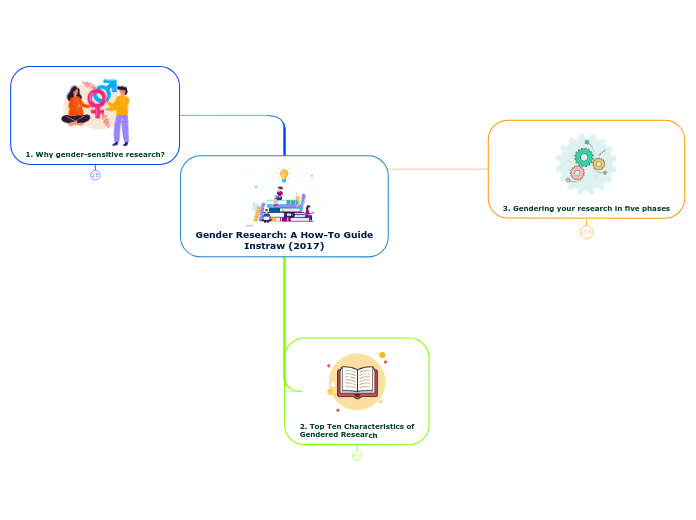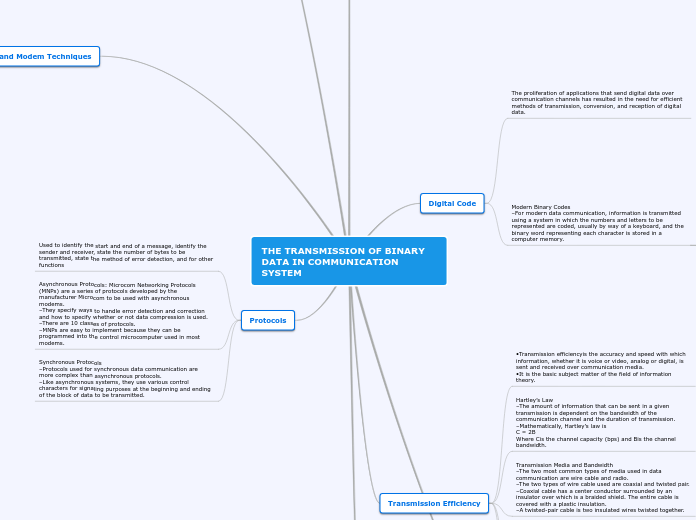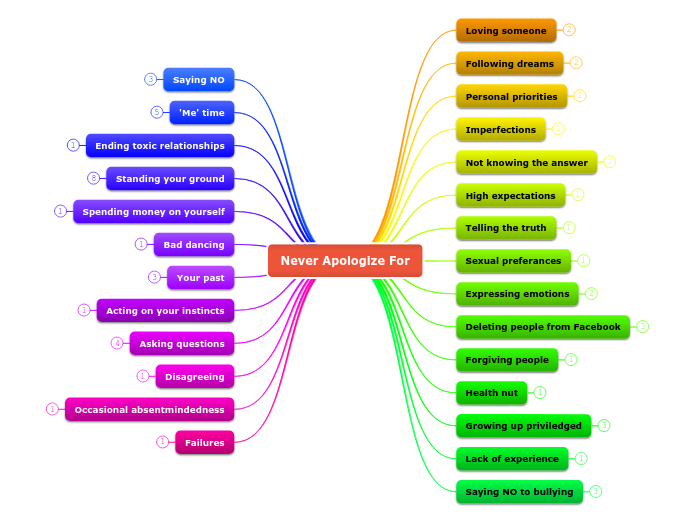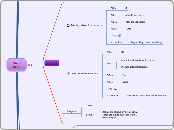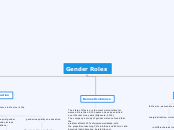Gender Research: A How-To Guide
Instraw (2017)
1. Why gender-sensitive research?
Women, gender and research
The importance of taking both sex and gender
differences into consideration
Health care and medicine development
Gender differences
Lung cancer mortality rate
Smoking is consider an atractive marker of masculinity
Societal standards
Married woman contracts HIV
Prevents women from insisting on condom use
Encourage men's promiscuity
Community norms
Prevent women from traveling alone to a clinic
Biological differences
Sex hormones
Contraceptives
Menopause
Menstrual cycle
Pregnancy
1970: Field of development
Programme design and implementation
Policy formulation
Research
Inequalities and insecurity
Violence
Sexual
Domestic
Feminisation of poverty
Women have a higher incidence of poverty than men
2. Top Ten Characteristics of
Gendered Research
10. Research as political action
Create social change
Generate a concrete impact on policy and programme formulation
9. “Non-traditional” qualitative research methods
Include the voices of the research participants
Personal histories
Life stories
8. Analysis of power hierarchies
Taking action to address power inequalities
7. Inter-disciplinarity
Topics from multiple academic fields
6. Critique of standard science and social science research theories and methods
Questioning the concepts of objectivity and universality
Valuing experimental knowledge, emotions and self-reflexivity
5. Changing the research process
Doing research to empower women
'Doing research with people rather than on
them'
4. Inclusion and diversity
Include all the target groups
Especial attention to the marginalized groups
3. Gender vs women
Understand the definitions
Women are not a single homogeneous group
Religion
Age
Ethnicity
Class
2. Gender analysis
Examination of information
In order to
Redress
Understand
Identify
1. Gender roles and relations
Power relations
Tend to favour men at different levels
International
National
Local
Household
Socially-constructed roles
Implie different
Opportinities
Behaviours
Norms
Are the results of being born male or female
3. Gendering your research in five phases
Phase Five: Reflexivity and Lessons Learned
Refelct not only on the resear subject but also on the way of conducting reseach in general
How successful were you in getting the community involved?
Did you uncover any gender-related issues in your research that need further examination?
Researches can reflect, examine critically and analyse the process
The presentation
The solution
The outcomes
The project
The research
The methods
Phase Four: Communicating your results
The use of research for social change
Raise public awareness
Change public opinion on issues such as violence against women
These findings can be reported to general public or specific target groups
How will you present these messages
and your findings in an accessible way?
What is the message that you would like
to communicate?
Requiere more accessible mode of communication
Radio
Television
Public meetings
Theater
Information campaigns
Creation of political will
Institutional commitment to address and resolve the problem
Example
Transmission of HIV/AIDS
Violence against women
The communication of research results depends on the main audience
Teleconference including visual aids
Report on an organization's website
Written report
Phase Three: Analyzing the data
Examination of information on gender differences
Do women and men have differential
access to water?
Who travels to collect the water –
what role do gender relations play?
The findings must be used to shape the design of policies
Phase Two: Choosing your methods
Qualitative methods
Participant observer
The most time-consuming method
Attempt immersion in local life to identify
Structure
Conflicts
Internal relationships
Dynamics
Values
Focus group discussions
Take into account men and women's experiences
Should be structured so the participants are both given the liberty to discuss the issues
Life histories
Discuss those issues that could be pertinent
Personal perspective and information related to different issues
Open-ended interviews
More detailed and personal informartion
Quantitative methods
Include
Numerical methods
Laboratotry experiments
Surveys and questionnaires
Take into account the target group experiences
Sensitive questions to both gender
Choosing the method depends on the questions formulation process.
Documents specifically focusing on women
and gender aspects?
Have women been involved in drafting
these documents?
Data is collected from two sources
Primary research
Participants
Secondary research
Documents
Phase One: Choosing research topics and research objectives
Indicators design
What data will be needed in order to measure the impact of your research?
What is the end goal that the research hopes to achieve?
Meassure the effectiveness of the project
For example
Gender equity
Number of children
Household income
Level of education
Should be formulated in a participatory way
Always considering the perspective of women
Meassure the progress of a specific programme
Track changes in gendre relations
Boys
Girls
Men
Women
Research question formulation
Consider how men and women are affected by an issue
How does the issue affect men and women differently?
How will this research affect men and women differently?
Identify the stakeholders
Questions
How might these policies affect men and women
differently?
Will the results as well as the process itself be empowering or
disempowering for women?
